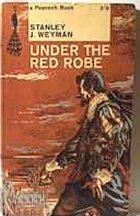 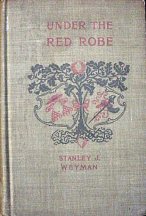 Under
the Red Robe:
A Romance: 1898 (copyright 1894) Longmans, Green & Co. 340 pages or
Methuen 1894 Under
the Red Robe:
A Romance: 1898 (copyright 1894) Longmans, Green & Co. 340 pages or
Methuen 1894
Contains a dozen full page
illustrations by R. Caton Woodville or illustrated by Edmund J. Sullivan.
G&D 1923 Photoplay
edition illustrated with film stills from the version directed by Alan
Crosland & starring John Charles Thomas as Gil de Berault & Robert
B. Mantell as Cardinal Richelieu. Besides the 1923
film adaptation, an earlier silent version was done in 1915 & probably
does not survive, & a fine talkie version was done in 1936 directed
by Victor Sjostrom & starring Conrad Veidt as Gil de Berault &
Raymond Massie as Cardinal Richelieu. It was dramatized for the stage in
London, at the Haymarket, in 1896, & was produced as a New York musical
in 1927. Rightly noted as "The author at his best" in A Guide to the Best
Histroical Novels & Tales. It is a Dumas-esque swashbuckler of 1630s
France, which a critic at the New York World thought the equal of Ivanhoe.
The "red robe" aludes to Richelieu. The hero, de Berault, is a gentleman
rogue who falls afoul of Richelieu & is given a choice between the
Bastille or being sent on a secret mission against the Hapsburgs. Being
a rogue his dubious mission seems a good one at first, but he falls in
love with the sister of the man he is sent to betray & soon redeems
himself valiantly. A rousing tale set largely in Bearn, & one of Weyman's
finest. The London 1st edition is rather rare but there are many later
printings.
1937 Film Adaptation:
The great Swedish director Victor Sjostrom (billed here as "Seastrom")
came out of semiretirement and ventured to England to direct UNDER
THE RED ROBE. Handsomely mounted, with a strong cast, the film is set
in France during the reign of Louis XIII. Gil de Berault (Veidt), a notorious
gambler and duelist, finds himself facing the gallows. At the last moment
he is offered a reprieve by Cardinal Richelieu (Massey) on the condition
that he seek out and kill a duke suspected of being the leader of the antimonarchist
Huguenots. Veidt agrees and finds himself accompanied in the venture by
Massey's trusted assassin (Brent), who is assigned to make sure that Veidt
does his job. Veidt traces the rebel leader to a castle and infiltrates
his stronghold, only to fall in love with his prey's beautiful sister (Annabella).
Veidt captures the duke, but rather than kill him or bring him back to
Massey for execution, he lets the rebel escape to England. When Veidt returns
to Massey and the king (Gardner), Louis praises him for the clever way
he removed the threat to the crown. Angered, but forced to concur, Massey
also congratulates Veidt. His neck out of the noose, Veidt returns to Annabella
to renew their romance. While certainly not among Sjostrom's masterworks,
UNDER THE RED ROBE is a fine costume adventure. Massey attacks his menacing
role with relish, while Veidt, who was a bit too old for his part, rises
to the occasion and pulls off the action scenes as well as the romance.
French actress Annabella, who was treated as a national treasure by her
countrymen following her performances in Rene Clair's LE MILLION (1931)
and JULY 14TH (1933), left France for England to make this picture and
two others. She then went to Hollywood, where she failed to duplicate her
European success. Sjostrom directed no more films himself, but concentrated
on acting and appeared in several movies, most notably giving a superb
performance in Ingmar Bergman's WILD STRAWBERRIES (1957).
Other:
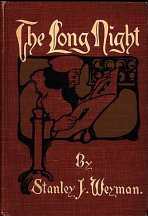 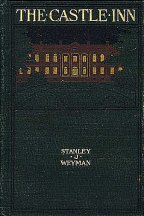 The
Long Night: 1903 McClure Phillips, 1903. 15 stunning action-oriented
illustration plates by Solomon J. Solomon. A scarce, horrific supernatural
adventure set in Switzerland early in the 1600s at the time when D'Aubigny
attempted to take Geneva, disrupting a generally peaceful period. The treacerouis
syndic is bribed by the demonic Basterga's knowledge of the Elixer of Life. The
Long Night: 1903 McClure Phillips, 1903. 15 stunning action-oriented
illustration plates by Solomon J. Solomon. A scarce, horrific supernatural
adventure set in Switzerland early in the 1600s at the time when D'Aubigny
attempted to take Geneva, disrupting a generally peaceful period. The treacerouis
syndic is bribed by the demonic Basterga's knowledge of the Elixer of Life.
Online eText Editions
The Castle Inn: 1898
Longmans Green, Tissued frontis illustration shows a highway scene of a
stagecoach racing madly, the driver's flintlock firing at pursuer. Plus
five more spectacular illustrations by the great Walter Appleton Clark.
Opening in the year 1767 on the old Oxford Road. A pistols-&-swords
swashbuckler of underworld life in jolly old England, when George III was
young, "when sign-posts served also as gibbets, when travel was by coach
& highwaymen were many, when men drank deep & played high," to
quote a Detroit Free Press review.
From
the Memoirs of a Minister of France
A
Gentleman of France ~ Also
1921 Film Adaptation
The
House of the Wolf
The
Castle Inn
Under
the Red Robe |
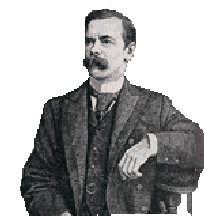 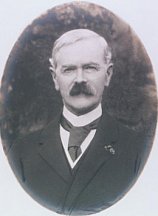
STANLEY
JOHN WEYMAN "Prince of Romance" was the central figure of the Romantic
Nineties' Golden Age of the Swashbuckler.He streamlined the best
of Dumas & Scott bringing the genre to the height of perfection.
Bio
and Biblio
Stanley
John Weyman annotated bibliography
Stanley
John Weyman (pronounced Wyman) was the second of three sons born to
solicitor Thomas Weyman and his wife Mary Maria Black on August 7, 1855,
at 54 Broad Street, Ludlow, Shropshire. He attended King Edward VI
Grammar School, Shrewsbury School (after age 16) and obtained a second
class degree in Modern History at Christ Church, Oxford in 1877.
As History Master at King's School, Chester, he served under his future
brother-in-law, Rev'd. George Preston. In Ludlow in 1879 he read for the
Bar and was called in 1881, to begin a disappointing law career with Weyman,
Weyman and Weyman, the family law firm. He has been described as
nervous, shy, short in height and a poor cross-examiner and was said to
have angered a judge because of these shortcomings. It is to our
blessing that Weyman's law career was unsatisfactory. As a result,
he was able to devote his ample spare time to writing. James Payn,
editor of Cornhill Magazine, encouraged him to tackle larger literary works.
The House of the Wolf was serialized in the English Illustrated Magazine
in 1888/89 and was published in 1890 after Weyman contacted literary agent,
A. P. Watt. This first book received no less than six rejections by publishers.
Two additional books, The New Rector and The Story of Francis Cludde, were
published in 1891 and these allowed him to become a full-time novelist.
Beginning his professional literary career in middle age, Weyman had a
lifetime of experience to share including the insights gained from his
extensive travels. On one notable vacation in the south of France
in 1886, for a "weakness in the lungs" in the company of his younger brother
Arthur, both were arrested as spies for sketching and crossing the border
into Spain. They were detained for 24 hours until the British Ambassador
helped them. Experiences such as these are reflected in his novels.
Stanley Weyman was a man of few words but those that were given were meant
to be savoured. As an author, he had an uncanny way of using precisely
the correct phrase. With his eloquent and extraordinary use of language,
he painted a vivid picture of life and human emotion. His work
is finely honed by a razor sharp mind that combines the skill of a great
storyteller and an Oxford scholar's love of history. Weyman's fame stands
on the foundation of his historical, romantic fiction. The 15 novels
written between 1890 and 1904 are set amidst the turmoil of 16th and 17th
century France. Weyman was one of the first authors to 'cast the romance
of adventure' in the historical framework. He was able to resurrect the
great heroes and bring them to life by his loving hand. This author claimed:
"The graves of our heroes--the real heroes--move us; the doors through
which the famous dead have passed are sacred to us." Stanley Weyman
regarded himself as fortunate that the timing of his early novels followed
closely the popular historical fiction of Alexandre Dumas in France. Well
known in its time was Under the Red Robe, an extremely popular
novel with several stage productions and movies (1923 and 1937) to its
credit. A duelist and gambler, Gil de Berault, is saved from the
gallows by Cardinal Richelieu and sent on a mission to capture a Huguenot
rebel causing trouble in the south of France. M. de Berault falls
in love, becoming a victim in his own web of deceit and discovers that
life without honor is death.Weyman was married to Charlotte Kate Eliza
Panting, daughter of Rev'd. Richard Panting (former head of Shrewsbury
School) on August 1st, 1895 at Great Fransham, Norfolk. They went to live
at Plas Llanrhydd, also known as Llanrhydd Hall, built in 1620, near Ruthin,
North Wales. Weyman is quoted as saying he was going to "grow books and
cows, the former for profit and the latter for pleasure". True to
his word, he wrote approximately 1000 words a day. After World War I, Stanley
Weyman decided to come out of retirement and continue writing. In 1919
he tested public opinion by writing a book Madam Constantia under the pseudonym
of Jefferson Carter. It was a success and confirmed his popularity. He
continued his authorship under his own name. In the Weyman novels you will
meet the man who lived and wrote about an honorable life, fully aware of
the human pitfalls and weakness of man. He was the "Prince of Romance"
that "never grew up" and he cherished his youthful imagination. His
marvellous stories are "pleasant fables" that demonstrate how courage and
love will triumph over adversity. Admired by renowned authors such as Stevenson,
Wilde, and Rafael Sabatini, Stanley John Weyman is today a forgotten literary
giant of the late 19th century. While for years his best-selling historical
romances enchanted thousands of readers, today his books are mostly neglected.
http://www.geocities.com/weymanforever/index1.html |

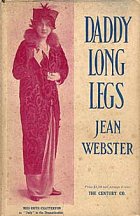
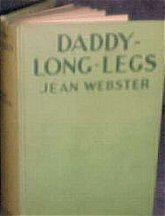
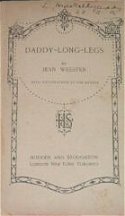
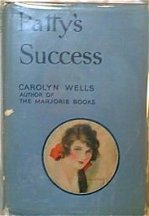
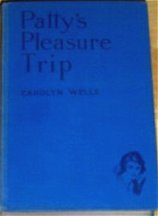
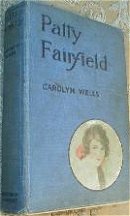
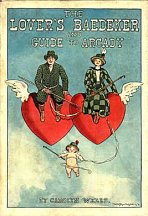 The
Lover's Baedeker and Guide to Arcady. NY: Frederick A. Stokes Co. (1912).
Illustrations, front cover and dustjacket art by A. D. Blashfield and Maps
by George Hood. Fantasy title missed by Bleiler in the format of a 'Baedeker
Guide' for the "city of Arcady in the kingdom of Arcadia, which is inhabited
entirely by a strange but interesting race known as Lovers. After describing
how it is to be reached by the Joy Line across the Sea of Dreams in transports
of rapture, she tells of its topography, its climate, time, custom-house
regulations, flowers
The
Lover's Baedeker and Guide to Arcady. NY: Frederick A. Stokes Co. (1912).
Illustrations, front cover and dustjacket art by A. D. Blashfield and Maps
by George Hood. Fantasy title missed by Bleiler in the format of a 'Baedeker
Guide' for the "city of Arcady in the kingdom of Arcadia, which is inhabited
entirely by a strange but interesting race known as Lovers. After describing
how it is to be reached by the Joy Line across the Sea of Dreams in transports
of rapture, she tells of its topography, its climate, time, custom-house
regulations, flowers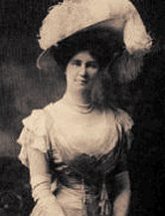
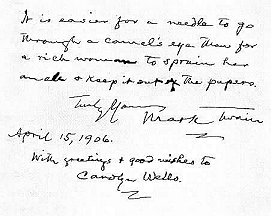
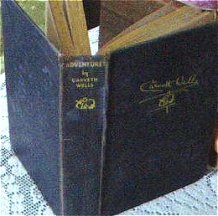

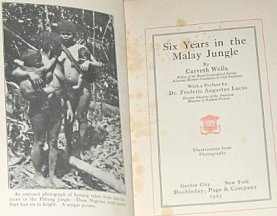
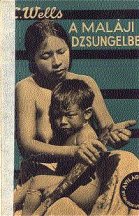
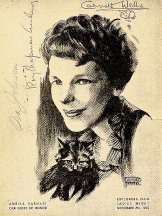 AMELIA
EARHART and OTHERS. Program signed: "Amelia Earhart", "Osa Johnson", "Roy
Chapman Andrews" and "Carveth Wells", who has drawn an elephant, 4p, 5x6¾.
Earhart's signature is in ink, other signatures in pencil. Explorers Club,
Ladies Night, 1932 November 7. Picturing a drawing of Earhart with a kitten
on the cover. The program includes a biography of Earhart, in part: "First
woman to fly the Atlantic, as one of the crew of three on the FRIENDSHIP,
the tri-motor Fokker, in 1928. First woman to fly the Atlantic solo June,
1932. (Amelia Earhart and Lindbergh alone have made eastward solo flights
and Mollinson the Western flight) First woman to make a non-stop trans-continental
flight, September, 1932, which also set long distance flight record (2400
miles) for a woman. Time from Los Angeles to Newark about 19½ hours...."
Lightly creased and soiled. 1¼-inch horizontal tears at blank margins
of front and back cover have been repaired with tape. Overall, fine condition.
Accompanied by a tattered 4½x6 sheet, written in unknown hand by
someone present: "Amelia Earhart gave a kitten to the new Club house -
anointed (sic) its paws with oil 'to keep it from straying.' Got a bit
of oil on her beige dress and when she sat down, I heard her husband Putnam
chide her for it." Fragile, chipped and torn. AMELIA EARHART's husband
was GEORGE P. PUTNAM, whom she had married in 1931. In the 1930s, pilot-photographers
OSA JOHNSON and her husband Martin Johnson delighted audiences in theaters
with films of their aerial safaris throughout Africa and Borneo. Naturalist
and paleontologist ROY CHAPMAN ANDREWS, Chief of the Asiatic Exploration
Division of the American Museum of Natural History, was best known for
his discovery of previously unknown Asiatic fossils. CARVETH WELLS was
an explorer, world traveler, author and radio commentator. Two items.
AMELIA
EARHART and OTHERS. Program signed: "Amelia Earhart", "Osa Johnson", "Roy
Chapman Andrews" and "Carveth Wells", who has drawn an elephant, 4p, 5x6¾.
Earhart's signature is in ink, other signatures in pencil. Explorers Club,
Ladies Night, 1932 November 7. Picturing a drawing of Earhart with a kitten
on the cover. The program includes a biography of Earhart, in part: "First
woman to fly the Atlantic, as one of the crew of three on the FRIENDSHIP,
the tri-motor Fokker, in 1928. First woman to fly the Atlantic solo June,
1932. (Amelia Earhart and Lindbergh alone have made eastward solo flights
and Mollinson the Western flight) First woman to make a non-stop trans-continental
flight, September, 1932, which also set long distance flight record (2400
miles) for a woman. Time from Los Angeles to Newark about 19½ hours...."
Lightly creased and soiled. 1¼-inch horizontal tears at blank margins
of front and back cover have been repaired with tape. Overall, fine condition.
Accompanied by a tattered 4½x6 sheet, written in unknown hand by
someone present: "Amelia Earhart gave a kitten to the new Club house -
anointed (sic) its paws with oil 'to keep it from straying.' Got a bit
of oil on her beige dress and when she sat down, I heard her husband Putnam
chide her for it." Fragile, chipped and torn. AMELIA EARHART's husband
was GEORGE P. PUTNAM, whom she had married in 1931. In the 1930s, pilot-photographers
OSA JOHNSON and her husband Martin Johnson delighted audiences in theaters
with films of their aerial safaris throughout Africa and Borneo. Naturalist
and paleontologist ROY CHAPMAN ANDREWS, Chief of the Asiatic Exploration
Division of the American Museum of Natural History, was best known for
his discovery of previously unknown Asiatic fossils. CARVETH WELLS was
an explorer, world traveler, author and radio commentator. Two items.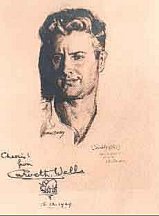

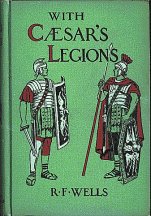
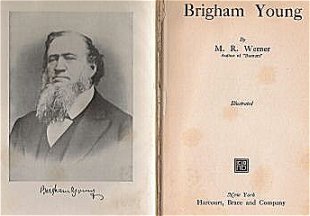



 The
Long Night: 1903 McClure Phillips, 1903. 15 stunning action-oriented
illustration plates by Solomon J. Solomon. A scarce, horrific supernatural
adventure set in Switzerland early in the 1600s at the time when D'Aubigny
attempted to take Geneva, disrupting a generally peaceful period. The treacerouis
syndic is bribed by the demonic Basterga's knowledge of the Elixer of Life.
The
Long Night: 1903 McClure Phillips, 1903. 15 stunning action-oriented
illustration plates by Solomon J. Solomon. A scarce, horrific supernatural
adventure set in Switzerland early in the 1600s at the time when D'Aubigny
attempted to take Geneva, disrupting a generally peaceful period. The treacerouis
syndic is bribed by the demonic Basterga's knowledge of the Elixer of Life.










